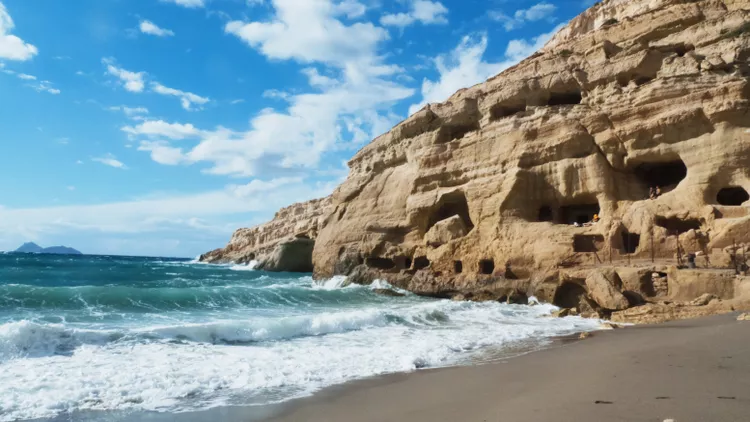Summary of the Caves of Matala
The famous caves of Matala in the Greek islands pock the face of the headland forming the north side of the small bay. Dug into the soft stone at regular intervals, they almost look like cabin balconies on the sinking-ship shape of the headland itself; earthquakes have tilted the entire landmass, contributing to the effect.
The tombs, by Greek or Minoan standards, are generally considered to not be that ancient, the product of local Roman occupation about two thousand years ago. However, official information on the tombs is scanty, and the ticketing booth was burned down one winter. While a fence still surrounds the area, the entrance fee collection is random and often the gate is open for free access until dark when the floodlights snap on and illuminate the cliffs.
Exploring the Caves
One interesting artifact is a large, plain limestone sarcophagus, minus its lid, which sits to one side of the fenced area. Within the caves, there are a few remnants of wall painting, some ancient, some from the 1960s when, allegedly, a few of the caves were covered with glow-in-the-dark paints.
Outside the caves, there are some interesting aggregates which may be the remains of earthquake-driven tsunamis hitting Matala, possibly after the earthquake in 365. You’ll see dirt, shells, brick, bone, wood, and other items seemingly cemented together.
Prehistoric Families
Some caves suggest domestic occupation in prehistoric times. This may be truer of other, natural caves located elsewhere in the hills around Matala.
The Dead
The first “occupants” were the burials, which may have preceded Roman times. While some of the tombs do appear to be Roman-era, with arches and benches carved into the stone, others are simpler and maybe even older. The tombs themselves are somewhat similar to the necropolis in Alexandria, Egypt, and tombs in Italy built by the Etruscans who may have descended in part from Minoan colonists. It is known that Matala and the south coast of Crete traded extensively with Egypt in Roman times.
Fishermen
The caves offer easy access to the sea, and local memory suggests that fishermen used some of them at different times as temporary housing. There are still a few caves on the opposite side of the harbor which are bigger and used to this day for the storage of fishing equipment–as well as a fisherman or two (at least for short periods).
Gypsies
The Rom arrived in Crete very early in their European history, and have lived on the island for nearly seven hundred years. Accounts of the Gypsies on Crete mention that they sometimes lived in caves.
Beatniks and Hippies
While the caves are most famously associated with international hippies living in them, one Cretan man told us that even before the “hippie era,” Matala was popular with the local Cretan counterculture–himself included–in the late 1950s. The foreigners arrived later, many of them arriving after a Life magazine photo spread on Matala. These foreigners included such luminaries as Joni Mitchell, who mentions Matala in her song “Carey” on the album Blue. Allegedly, Bob Dylan, Cat Stevens, and a number of other later-famous musicians also visited the caves of Matala.





